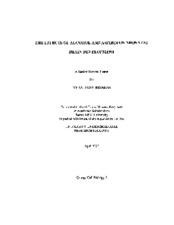| dc.description.abstract | This study focuses on the effects of alcohol and aspirin on brain development in the neonatal rat. The period of brain development of particular interest is known as the brain growth spurt. Previous studies have shown that the developing brain is particularly vulnerable to alcohol and other drugs during this period. The brain growth spurt occurs in humans in the third trimester of pregnancy, whereas in rats it occurs in early postnatal life. To extrapolate results from the rat species to the human species, the timing of the brain growth spurt must be equated. For this reason, the neonatal rats were artificially reared from postnatal day (PD) 4 to PD 9. They were randomly assigned to one of nine experimental groups. Treatments for the eight artificially reared groups included various doses of aspirin, alone or in combination with a single dose of alcohol, or no drug treatment (gastrostomy control). The ninth group was a suckle control group, and these animals were reared by their mother. The alcohol-treated groups received 4.5 g/kg/day of ethanol and either 0.0, 12.5, 25.0 or 50.0 mg/kg/day of aspirin in a milk formula solution. The remaining groups received 0.0 (gastrostomy control), 12.5, 25.0, or 50.0 mg/kg/day of aspirin in a milk formula solution that contained no alcohol. Body weights were measured daily, and forebrain, cerebellum, and brainstem weights were measured on PD 9. Forebrain, cerebellum, and brainstem weight to body weight ratios were calculated, and a significant effect of alcohol was observed for each ratio. The brain weight to body weight ratios were significantly smaller for the alcohol-treated groups when compared to the non-alcohol-treated groups. However, a significant effect of alcohol on body weight was not observed, which indicates that the brain weight to body weight ratios were smaller for the alcohol-treated groups due to a vulnerability of the brain tissue to alcohol treatment. | en |


